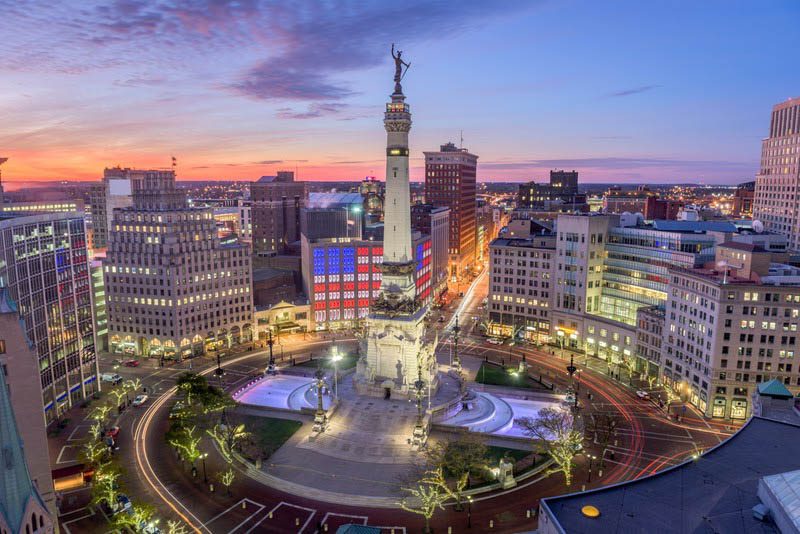Home » Cost Guides » Indiana Cost Guides » How Much Does It Cost to Build a House in Indianapolis?
Indianapolis, also fondly called “Indy,” is the largest city in the state of Indiana. A sports-crazed city, it is known for hosting some of the largest sporting events in the country such as the Super Bowl, the Indy 500, and the Indiana Grand Prix. As the “Racing Capital of the World,” motor sports are especially popular in this city. Despite the popularity of car racing in the area, many health-conscious, green locals (nicknamed “Hoosiers”) prefer to bike instead of drive. Moreover, Indianapolis has launched homegrown ride-sharing companies to lower Hoosiers’ dependence on cars and promote sustainability.
In addition, Indianapolis is a center for travel. Informally known as the “Crossroads of America” due to the presence of the USS Indianapolis Memorial Highway. This circular roadway is a combination of four national highways serving as a “national nexus” of commercial, industrial, and recreational travel. Indianapolis therefore also has many cultural attractions, including the world’s largest children’s museum, various motor speedway museums, and war and military museums. The city derives a significant portion of its income from tourism, drawing in an average of 29.9 million visitors yearly.
With more than 35% of the population being under the age of 25, Indianapolis is considered one of the best cities for creating tech jobs, a great city for women in tech, and one of the best cities for renting in America. The relatively low cost of living combined with many possibilities for employment make Indianapolis an ideal place for young adults to settle down or raise families. Those who wish to live in an accessible big city with a small-town feel will find themselves right at home in this town.
The Cost of Building a Custom Home in Indianapolis
The average sale price of a house in Indianapolis is still lower than the national average in 2021. According to a May 2021 report from the Metropolitan Indianapolis Board of Realtors (MIBOR), the median sale price of a single-family home in Indianapolis is $255,000. Though homes are relatively more affordable in this region, their prices also follow the upward trend seen on a national level. In the past five years, home values in Indianapolis have increased by over 62%. Forbes Magazine regards Indianapolis as one of the top housing markets of 2021, with 65% of homes for sale being taken off the market within two weeks.
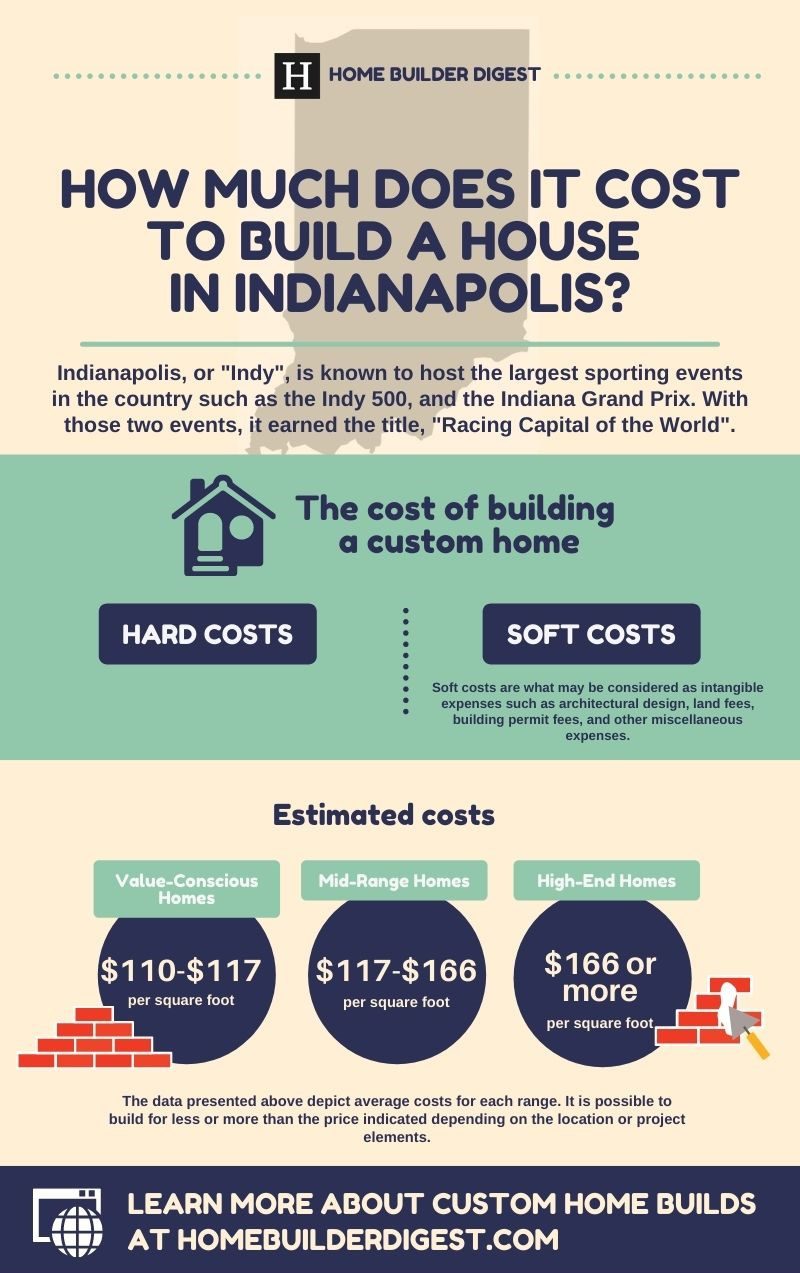
Aspiring homeowners can expect to shell out up to $471,474 to construct a new home. At face value, this number appears larger than the average cost of new home construction in the United States. However, it’s important to note that homes in Indianapolis are approximately 150% larger than the typical U.S. home. Ranking number one among cities in America with the biggest lots, Indianapolis’ median lot size amounts to almost 9,200 square feet. Floor areas run an average of 3783.99 square feet. With all this information, old and prospecting Hoosiers have one question: how much does it cost to build a house in Indianapolis?
The cost of constructing a new home varies with the labor and resources needed for it, most of which have prices that fluctuate independently. Building a home requires a lot of various charges, such as architecture and design fees, permit fees, land fees, and other custom features. With new home construction, however, most homeowners prefer building from the ground up, which will include the foundation, framing, plumbing, roofing and flooring. All of these are what make up the soft and hard costs.
Hard Costs
Hard costs include any expense that funds the physical structure of the house, such as the materials, landscaping, and labor. The median cost of new housing construction for the past two years in Indianapolis is $132.11 per square foot. This is lower than the national average of $138 per square foot. Estimates from BuildZoom bids place the price of value-conscious homes at $110 per square foot. Mid-value home design and construction may cost somewhere around $117, while for high-end, luxury homes, the figure can go at around $166 per square feet or more.
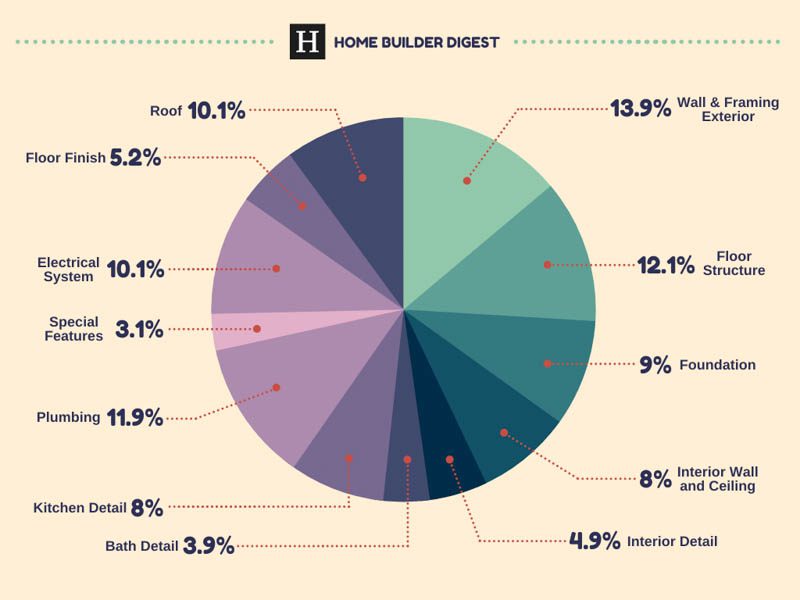
Figure 1. Typical cost breakdown of a single-family home constructed using the conventional method, according to Home Builder Digest.
Similar to other cities, Indianapolis is also struggling with increased costs of construction materials since last year. For example, an eight-foot 2’x4’ wood plank that would have cost $2 last year now costs around $8, while a 4’x8’ plywood sheet that only cost $10 in 2020 now costs anywhere between $45 and $60. However, framing lumber dropped its prices from $1,600 per thousand board feet around May this year to $500 this August.
Steel prices also increased due to high demand until earlier this year, but it is reported that steel mills are slowly increasing their production. Metal roofing nowadays may cost anywhere from $5,900 to $32,200, or roughly $5.90 to $9.20 per square foot depending on the size and material. It is important to note that roofing costs may also vary depending on the number of storeys, roof areas, and the pitch steepness. The price may also be higher if a standing seam is chosen. For instance, a basic standing seam metal roof for a 1,500-square-feet-space may be valued at $11,350.
The climate in Indianapolis can be described as warm continental, which means that summers are hot and humid, with the hottest month having an average temperature of 71.6 °F. In this climate, winters are cold with moderate snowfall. Installing a heating, ventilation, and air conditioning (HVAC) system may be advisable for new home constructions. Homeowners report that the average price for central air conditioning installation is approximately $4,630, but depending on the type of air conditioning system, it may cost anywhere between $3,350 and $5,910.

Soft Costs
Soft costs are what may be considered the intangible expenses that go to and beyond the physical construction of the home, such as architectural design, land development fees, building permit fees, engineering fees, and other miscellaneous expenses required by the city government.
Cost of the Land
Indianapolis ranks number one in the list of cities with the biggest lots, making it an ideal marketplace for people who want a big backyard. Zillow places the average price of land in Indianapolis at around $8.92 per square foot, and can go up to $64.75 per square foot. This median price, however, includes both developed and undeveloped properties within the city, and is exclusive of any fees that the government may impose upon purchase.
Permits and Other Fees
Residential development permits can be filed at the Department of Business and Neighborhood Services, although it requires that the person filing is either a licensed contractor or a property owner. Alternatively, the permits can also be filed and paid for online after creating a Citizen Access Portal account. Available services and fees include those for electrical, plumbing, HVAC, structural, and residential. All permits have an application fee of $32.00, and the permit and plan review costs for new primary structures are as follows:


Other permits may be needed before the builders can get approved for a structural permit. If a drainage permit is required, then the cost for New Primary Structure (Approved Subdivision) is $78, while for New Primary Structure (Metes and Bounds), it costs around $182. BuildZoom reports an average of $533.33 for new single-family home construction permits fees in Indianapolis from 2019 to 2020. Last year saw a surge in single-family building permits according to the Builders Association of Greater Indianapolis, with an increase of 66%. This year, a total of 8,039 permits were issued, which is 28% higher than 2020. However, with the increase in material costs and demand for new residential construction, it is expected that building activities, along with permit applications, will soon decrease.
Architecture and design fees
Hiring an architect averages to about 8-12% of total construction costs and construction management fees average to about 5-15%. However, some architects charge a fixed rate hourly and have different rates for remodeling versus building from scratch. Others combine the fees — starting out with an hourly rate, but charging per square foot once plans are established. Others, as mentioned earlier, simply calculate the fee based on the total construction cost. It is best to discuss the plan in depth, ask questions, and carefully weigh one’s options.
How do the custom home building costs in Indianapolis compare to other nearby cities?
BuildZoom permits place the average construction costs of new homes in Indianapolis at $471,474 for the average property size of 3,783.99 square feet. This is approximately $132.11 per square foot. Bellhop lists downtown Indianapolis as the most popular neighborhood to live in the city, where home prices increased by 1.5% compared to 2020, with a median price of $343,000. This is higher than the average housing price for Indianapolis, which according to MIBOR, is around $255,000, and is pretty low compared to these following Indiana cities and town:
Carmel
Typically, the Carmel housing market cools off around fall and winter, but the current demand is keeping it strong enough to last the whole year. Some homes are even selling above the listing price. As of October 2021, the seasonally-adjusted median home value was around $451,971, or around 15.8% higher than the previous year, and this includes only middle tier homes. Last year, Carmel City Council introduced an ordinance that will ease the cost of constructing accessory dwelling units, or “granny flats”, after housing prices increased drastically.
Fishers
Last July 19, developers pitched plans to construct a total of 313 new houses in east-side Fishers, and proposed prices for the new homes in Milford park range from $420,000 to $500,000. The median home price in Fishers by October is $360,463, which is already seasonally-adjusted and only includes middle tier homes.
Westfield
Lumber shortage is evident in the area as new residential construction costs rose with the price increase, especially when most new homes are wood-framed. As of October 2021, the median home listing price in Westfield was around $379,000, or $142 per square foot, with a year-over-year trend of 10.7%.
Zionsville
Last October 4, the Zionsville town council approved a housing development for 106 single family homes, each costing $450,000 or more. For the same month, the median home price in Zionsville was $535,000, or $143 per square foot, and is trending up by 10.3%.
Major Custom Home Building Cost Trends Across the Web for Indianapolis
The Indy housing market moves quickly. Buyers may find it quite competitive, with homes lasting an average of five days on the market with a median home sale price of $179,000. Even with a 15-20% price increase, these figures are still lower than the national median price indicated on Zillow.
Based on online forums such as Quora, Indianapolis is generally an inexpensive place to live. Well-paying jobs are mostly located in the northern part of the city, but residents do not consider this an issue because public transportation is not so expensive. Forum commenters praise the accessibility of the downtown center, which makes going out easy to do on a regular basis. Many new residents initially rent an apartment at lower prices compared to other major cities, but eventually opt to buy larger houses with more usable space. This is relatively easy to do due to the lower prices in Indy.
Locals online say that Indianapolis can be “as cheap or as expensive as one wants,” depending on their choice of location and lifestyle. Those who are willing to spend more for a luxurious lifestyle often opt to live in the northmost suburbs and downtown area, which are more expensive places to live. Those who are budget-conscious but still wish to live near the city center may want to consider a condo unit, which is a more affordable alternative to townhouses and single family homes. Purchasing a two-bedroom townhouse near downtown could set one back $350,000, whereas a two-bedroom condo unit in the same location may cost only $80,000.
What Leading Custom Home Builders and Architects that Serve the Indianapolis Area Say
To give more in-depth information about the housing market, we reached out to home builders and architects that serve Indianapolis and asked about the current costs of residential construction.
Christopher Short, principal architect and owner of HAUS | Architecture For Modern Lifestyles, and WERK | Building Modern (Architect-Led Design-Build), shares that while design fees may have variations with respect to the services offered and completed for a project, he prefers to collaborate with clients in a more comprehensive way. Design fees may vary depending on project scale, in addition to the scope of design services offered like basic, more detailed, or comprehensive. Basic design services could fall under 3-8% of the construction cost. More detailed, mid-level design services could be 4-11% of construction cost. As for high-value, comprehensive design services, design fees could range from 6-18% of the construction cost. The variations factor for differences in project scale and construction value. Economy-of-scale is certainly a factor in negotiating design services. There is no “one-size fits all”.
For construction costs, Short gives the following values for each home build tier:
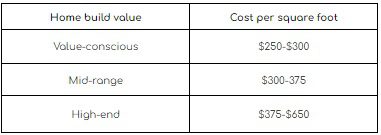
The value-conscious tier may apply to very large scope projects with mid-level design quality. This range is becoming more difficult to achieve at smaller scales. Mid-range is still a stretch for higher quality projects under 4,000 square feet. With this, Short’s companies are working almost exclusively in the “high-end” tier. They anticipate some possible decreases in construction costs for 2022 because of the increase in interest rates and reduced supply-chain issues. However, most building materials are expected to continue increasing into 2022, along with ongoing delays for various items. In 2021, they used a 20% inflation factor for residential construction, which was due to broader economic factors like politics, COVID, and the global economy.
Glenn Gareis, president of GMG Architects, developed a fee table, with a schedule based on the construction costs, materials and project complexity. For them, smallers jobs demand smaller fees, but with more overhead to carry against the smaller amount. The design fees start at $50,000, and may go up to $2,000,000. A percentage will then be computed depending on the project type and project cost. For example, remodeling with interior design and contractor assistance may add an extra 7-8%. A $340,000 project may have an additional 5%, while a $1,500,000 project can have around 3.32% of additional in fees. When it comes to the clients and their involvement with the design, business entities tend to get lower final fees because of careful planning and succinct decision making, compared to homeowners who tend to change their opinions on the design a lot more.
As for Sigma Builders, one of its principals, Dave Berman, shares that the lower cost of living in the city, combined with the lack of desirable lot inventory due to the 2008 recession, contributes to the higher home prices. While prices are on the rise, people are flocking the Indianapolis housing market due to the improved living and economic conditions at lower prices, which then gives them more opportunities to get a bigger and better home with lower property taxes. In general, the US is experiencing its lowest interest rates in history, which led to a buying frenzy. Berman also shares that their average construction time increased by 20% due to supply chain issues. Continuing their focus on contemporary builds, projects that took 10 months to complete now took 12 months or longer. They currently have a backlog of around 24 homes to close in 2022, which is a 100% increase from 2020. That said, he feels that this is minimal compared to the impact has seen for some other builders. He states that being decisive with the design and construction helps minimize the delay since they will be able to send in orders earlier. The firm has also been partnering with their tradesmen suppliers more closely, since increased communication and ordering the high lead time items earlier in the process is said to be the best approach shortening the building timeframe. Berman also referenced data provided by The Builder Association of Greater Indianapolis (BAGI) about some specific price increases and product availability:
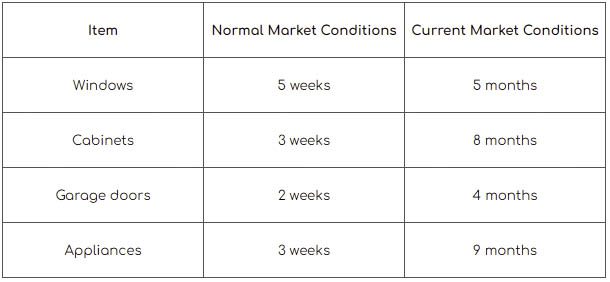
The price of cabinets increased by 12%, while garage doors increased by 100%. As for faucets, several manufacturers have cancelled at least half of their SKUs to streamline the production in their manufacturing plants. Berman estimates that their firm’s cost to build increased by over 30% from their usual project range of $1-2,000,000 since the pandemic. Their building times are also higher by 20%, but the good news is that lumber prices, while still much higher than normal, have lowered in recent months. The pandemic has negatively affected the workforce, and with the increasing orders, it may take some time for the supply and demand dynamic to normalize. In addition to those, the rising lot prices and cost to build all point towards the cost of home ownership growing for at least 12 months more.
The Future of Indianapolis’ Residential Construction Industry
Redfin predicts that 2022 will have a more balanced housing market, and that people will start moving to seek out affordable northern cities like Indianapolis, especially cost-conscious homebuyers. SmartAsset even ranks the area in the list of top 10 cities where people spend the least on housing as of April 2021. It is expected that home builders will soon be able to navigate the market better even with the supply chain issues due to COVID. Similar patterns as this year may be seen in 2022, but with fewer bidding wars and slower sales. Based on BAGI’s database, as of November this year, building permits have increased to 28% in the city compared to 2020 so contractors have a positive outlook towards 2022 especially when it comes to customization of homes.
Considering building a home in Indianapolis?
Contact us for a free consultation

